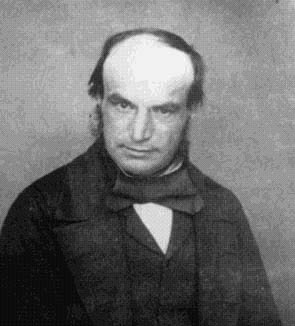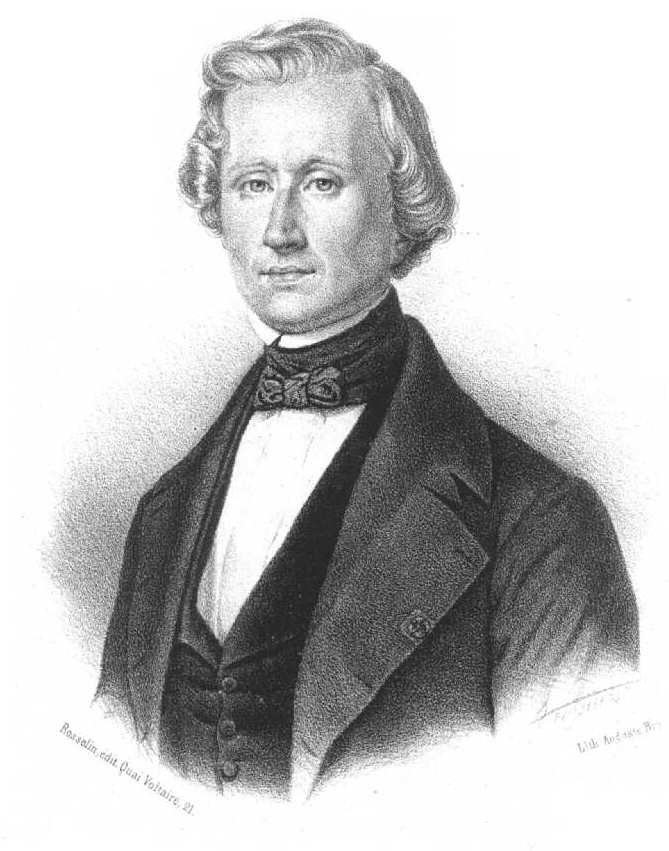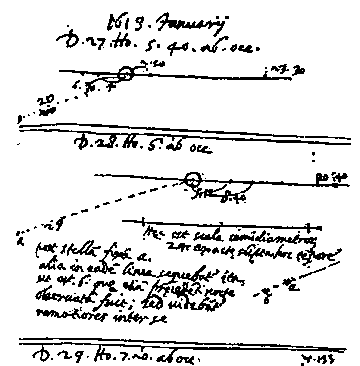Or the story of nice guy John Couch Adams and nasty guys James Challis and George Biddell Airy.
William Hershel discovered Uranus in 1781, as noted in an earlier blog entry of mine. This discovery doubled the size of the solar system and made William Hershel the most famous astronomer of the age. But could there be more planets?
First, we need to go back to Isaac Newton and his discovery of how gravitation works. The gravitational attraction between two bodies depends on the mass of the two bodies multiplied by the square of the distance between the bodies. However, in the real universe there are uncounted numbers of bodies which each attract each other. Unfortunately, the attraction that three bodies in motion have on each other cannot be solved, even in principle. Let alone many more. The three body problem has still not been solved. However, we can reach a very good approximation by solving the gravitational attraction and motion of two massive bodies and then adding a third body (either less massive or further away) and then a fourth body, a fifth, and so on. The changes in velocity these further bodies have on the first bodies included in the equation are called perturbations.
For instance determining the orbital behavior of the moon around the earth, you first solve how the earth and moon attract each other, then put in the sun, Jupiter, Venus, Mars, Mercury, and Saturn. This was very complicated, and determining the moon's orbit drove Newton to distraction--Newton himself said that the problem of the moon's motion was the only one that ever made his head ache.
While a perfect solution to a many-body problem is impossible, by taking into account all the perturbations of the planets the error can be made vanishingly small. By the end of the 18th century the motion of the planets agreed with Newton's law perfectly as far as the telescopes of the time could determine.
Solving the problem of Uranus' orbital motion was relatively simple. You had to account for the sun, a small perturbation from Saturn, another small perturbation from Jupiter--and that was it. The inner planets (Mercury, Venus, Earth and Mars) were too small and too far away to have a measurable effect on Uranus's orbit.
But then came trouble.
In 1821 the French astronomer collected all the observational data or Uranus's orbit. He even went back through all the observations back to 1690 (Uranus had been first seen through a telescope and charted in 1690, but until Hershel it was just assumed to be a star. One astronomer charted Uranus 13 times in the middle 1700s, and assumed he had charted 13 stars!
The observations didn't fit. The distance observed between Uranus's theoretical position and its actual position was never more than 2 minutes of an arc. Or one-fifteenth of the apparent diameter of the full moon. Astronomers were dismayed. They didn't want a discrepancy of 2 arc-minutes. There shouldn't have been a discrepancy like that at all!
How to account for this? One idea was that Newton's inverse-square law of gravitation was wrong. Suppose instead of falling off to the second power (d2), it really fell off at an exponent of d2.001? Or d1.999? Then Newton's inverse-square law would seem to be correct until observing a really distant planet like Uranus before the discrepancy showed up.
The other possibility was that there was another planet out there, one that could account for Uranus's orbital behavior. Which was correct?
There was some thought that Newton might be slightly wrong--and there could be no surer way to scientific fame that to discover and correct a flaw in Newton's gravitational equations! But most scientists in general and astronomers in particular were against this idea. Newton's d2 formula was aesthetic. It was elegant. And most astronomers didn't want to mess with elegance.
Enter James Adams who graduated first in his class in mathematics from Cambridge in 1841. He decided to try and solve the problem of planet 8. The behavior of Uranus put some boundaries on the problem. If planet 8 was on the other side of the sun, it would be too far to perturb Uranus. So they had to be on the same side. Uranus had been ahead of it's predicted position through the late 1700s and into the early 1800s, but was now falling back closer to its predicted position. That meant that Uranus had overtaken Planet 8 sometime in the early 1800s and that Planet 8 was now behind Uranus (Uranus, closer to the sun would orbit faster. The actual overtaking was later determined to be in 1822).
The closer agreement between Uranus's actual position and its theoretical position during the 1800s also made some believe it was observational error that was being resolved as telescopes improved. However, that did not explain why the errors in Uranus's position were all on the same side.
Adams made some simplifying assumptions. Since Saturn is roughly twice the distance of Jupiter from the sun, and Uranus twice as far as Saturn is, Adams assumed that Planet 8 was twice as far from the sun as Uranus is. Adams also assumed that Planet 8's orbit was perfectly circular. Adams knew very well that all planetary orbits are ellipses, but most planetary orbits are close to circular, and calculating orbits was complicated enough on paper without trying all sorts of different elliptical configurations.
So Adams did simplify things, and some of his assumptions were off. One in particular turned out to be far off. Planet 8 is not twice the distance from the sun Uranus is, but only 1.5 times as far. But Adam's simplifications were reasonable ones.
By 1845 Adams had completed his calculations, and determined that on October 1, 1845, and for the rest of the decade, Planet 8 would be in the constellation Aquarius.
Adams gave his results to James Challis, the first villain of the story. James Challis was director of the Cambridge Observatory. Adams hoped that with the Cambridge Observatory at his disposal, Airy would make observations with dispatch. Adams was wrong. Airy, knowing that the observational search was likely to be tedious and most likely turn up nothing, ducked. He told Adams he was too busy, but he did fob Adams off with a letter of recommendation to the Royal Astronomer, George Burdell Airy.
Airy was a petty tyrant, always a nitpicker for detail and missing the big picture. Much later in life, he labored over expeditions sent around the world to measure the exact times the disc of Venus intersected the sun during transits in 1874 and 1882. By measuring from different vantage points on the Earth the exact times Venus's disk began and finished crossing the sun, the distance of Venus from Earth could be calculated precisely--and therefore all the distances of the planets from each other and the sun. Airy failed to account for Venus's atmosphere, which had been known about since the last pair of transits in the 1700s. The blurring effect of Venus's atmosphere ruined the the observations, and Airy's very expensive expeditions were failures.
The only success Airy had was a personal one. He developed eyeglass lenses that could correct astigmatism. He was himself astigmatic, literally and figuratively.
Airy, whose harsh treatment of his assistants and disdain for students was legendary, was the main Adams tried to contact. His letters to Airy went unanswered. In the days before the telephone, telegraph, and widespread railroads, Adams went down to Greenwich to visit Airy. Airy wasn't home. He went again. Airy wasn't home that time either. On a third visit, Adams was left to wait in the entryway for an hour before being informed that Airy was having dinner and would not be disturbed.
Adams left his paper with Airy who leafed through it and wasn't impressed. Airy was convinced that Newton's inverse-square law was in error and that he was going to find the error and correct Newton! Airy was convinced there was no new planet 8. Airy then wrote back to Adams sending him calculations using an adjustment of the inverse-square law, and nitpicking on two spelling mistakes Adams made in his paper.
Adams, realizing that he was dealing with a petty idiot, didn't bother to answer. He gave up.
Meanwhile, across the Channel, a young astronomer, Urbain Jean Joseph Leverrier was also working on the same problem. He made the same assumptions Adams did, and located Planet 8 in the same part of Aquarius Adams had done. Leverrier had done some astronomical work and made some contributions (as Adams had not--Adams was a mathematician) and Leverrier had the support of his superiors. Leverrier published his calculations with his superiors' support. Leverrier made his calculations 6 months after Adams.
Airy read the paper, and wrote Leverrier back with irrelevant nit-picking objections. Leverrier wrote back, and pointed out that Airy's objections were irrelevant.
Airy was reluctantly impressed. He did not write back that Adams had made the same calculations, and never wrote back Adams either telling him about Leverrier. He certainly did not recommend Adams' paper for publication.
Airy then wrote Challis and told him to start looking for Planet 8. This Challis did, but in a desultory way, not comparing stars positions from night to night. He didn't even start looking for three weeks after he got Airy's letter. As the weeks went by, Leverrier, hearing nothing back from Airy or Challis, lost patience. It had been 9 weeks since Airy had written Leverrier that he would be leading the effort to find Planet 8, and after so much time, it was obvious that the English were not putting any effort into the search.
The director of the Berlin Observatory received Leverrier's letter on September 18, 1846 and he was interested. He asked the lead astronomer, Gottfried Galle to take care of it.
The next few days had lots of clouds, while Galle prepared for the obsevations. It would have been tedious work, but then a graduate astronomy student, Heinrich Ludwig D'Arrest, reminded Galle that the Berlin Observatory had been preparing new star charts more accurate than any before, and to see if Aquarius had been charted. It had been, only 6 months before! A lucky break!
The night of September 23 was clear. The Aquarius star charts were in their hands. Galle and D'Arrest got to work, moving the telescope methodically across the constellation, calling out the stars and their positions one by one. Only 30 minutes later D'Arrest cried out "That's not on the chart!" It was the planet! And it was only about 1.4 times the diameter of the full moon away from the predicted position!
Naturally Galle and D'Arrest observed the planet for a week, enough to determine its slow motion and a small disc. On September 30, 1846, they announced their discovery.
Once the discovery was announced, Challis went back over his observations and discovered he had observed Planet 8 four times but had not bothered to compare positions and did not know what he had seen.
Both Airy and Challis had made fools of themselves, and they knew it. Neither mentioned Adams' paper.
John Hershel, an English astronomer,, the son of William Herschel who had discovered Uranus, had heard of Adam's work and made sure it was published--and tried very hard to get proper credit to Adams, and publicized the incompetence of Airy and Challis. Herschel had long disliked Airy, considering him a tyrant and unfit for the position of Royal Astronomer. Herschel had also heard of Airy's abusive practices towards Herschel's and others' students, but his attempt to get Airy dismissed went nowhere. Airy tried to blackball John Herschel from astronomy in Great Britain, but Herschel's well-deserved reputation (as well as his father's reputation for discovering Uranus and infrared rays) prevented this.
The whole thing became a huge row. The French were convinced that the English establishment was trying to steal credit for calculating Planet 8's existence and position. The English raged about the perfidious French. The French offered a sop---name Planet 8 'Leverrier' and change Uranus (Georgium Sidus) back to Herschel. No one really liked that idea, however. Several astronomers suggested that since Planet 8 was blue-green in color, it should be named Neptune, for the god of the sea--and this was adopted.
Leverrier and Adams met and became friends.
In 1860, Challis retired as director of the Cambridge Observatory, and nominated Adams for the post, in what seems to have been an apology. Challis was not really evil---just slipshod. Adams stayed there for 21 years, until he was offered the post of Royal Astronomer when Airy retired, having served for 45 years. However Adams by this point was 61, and had suffered some illnesses, and did not feel up to taking the position, and became a teaching professor at Cambridge. Adams chaired the International Meridian Conference in 1884, which set the Greenwich Observatory as the Earth's prime meridian for time. Adams and Airy both died in January 1892.
Gottfried Galle survived to July 1910, one month past his 98th birthday.
John Couch Adams
Urbain Jean Joseph Leverrier
It needs to be said that none of the people in this entry were the first to see Neptune. The first person to see it (and the first person to actually be first to see a new planet, since Uranus is visible to the naked eye) was Galileo--who observed it near Neptune December 27, 1612--more than 200 years before its discovery!
In this drawing, Neptune is the 'star' in the green box with the notation 'fixa' or fixed--as in a fixed star. Here is the image from Galileo's notebooks:
Galileo's notebook from January 27, 1613
Interestingly in July 2009, David Jameson, a physicist from Melbourne Australia, discovered that Galileo used a different type of ink to mark Neptune's location in the January 1613 observation--one different from the rest of the page. Neptune was just turning retrograde in December 1612, its motion was not apparent. But it was moving more quickly against the fixed stars by late January 1613. Was Galileo aware that he had discovered a new planet? His notes don't say. But it is interesting that he used a different ink to mark Neptune, and that he did not label it a fixed star.
Perhaps he thought that the discoveries he had publicized were disturbing enough to the church--another planet that could not be seen with the naked eye would be just too much. So he kept the knowledge to himself--knowing the world was not yet ready for it. I'd like to think that was so.




Standish and Nobili are the ones who discovered that 4th observation of Galileo; not Jameson. It is reported in the "Proceedings of the International Conference honouring Heinrick Eichhorn held at the Vienna Observatory, Austria", May 25-26, 1998. Obscure, yes; but, documented.
ReplyDelete